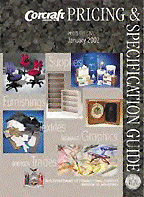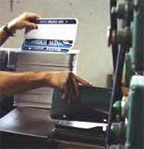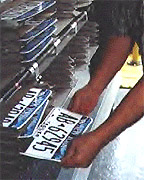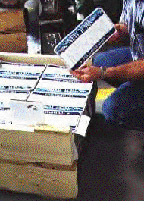|
-- the Relationship between Auburn and the Prison© CUSTODY & SECURITY
In 1982 the Department of Correctional Services adopted a redeployment plan for security staff. Many new correction officers and supervisory positions were created at Auburn. The correction system is career-oriented with promotions from the ranks available. In-depth, in-service training assists employees to understand and cope with the complexities of interpersonal relationships with inmates, co-workers, and supervisors. Security against escape by inmates and productiveness of labor of inmates were the two demands of legislators and the public during the 19th Century. Security against escape from with the walls at Auburn has been perfect since the 1929 riots; no one has escaped since July 28, 1929. Several attempts at escape have been thwarted by alert officers.
Much of the stability of the facility in the period following the inmate disturbance of Nov. 4, 1970 can be credited to the appointment of Robert J. Henderson to serve as Superintendent effective April 1, 1971. He was in charge during a very difficult period in the history of the prison. He accomplished a post-riot restoration, bringing the facility back to normal operations. Henderson was instrumental in creating changes in programs for inmates. Additionally, during his 18 years in charge, he guided the many pilot programs and staff training programs instituted at Auburn THE PRISON IN THE 1990s Auburn Correctional Facility today continues to be a walled, maximum security facility prison for male felons, but its plant has been modernized. Actually the physical plant is only 64 years old, as all original buildings have been rebuilt since 1928. The most recent addition is a health care center building opened in 1987. The facility is responsible for providing certain health care services and mental health care services in the same sense it must provide food, housing and clothing for inmates. Other existing programs are designed to provide prisoners with work, educational opportunities, and guidance in the hope that ultimately they may return to society as law abiding citizens. Religious guidance has formed an integral part of programs at Auburn since the very beginning. Worship services are conducted weekly for members of Catholic, Protestant, Jewish, and Islamic religions in the chapel which is a refuge and source of solace in the abnormal world of prison. Chaplains provide individual counseling to inmates in private. Many Bible study groups and education classes sponsored by volunteers from the community also provide encouragement and stability to the men confined. CORCRAFT INDUSTRIES Prisons are no longer expected to be self-supporting through the sale of products produced by the labor of inmates. There has been little change in the statutory basis of correctional industries since the enactment of the State Use Law near the end of the 19th Century. At times more restrictions have been passed to suppress any perceived or actual threat of prison labor displacing private workers. Nevertheless, the work program at Auburn has been self supporting and able to show a profit, largely due to the manufacture of over 3.5 million license plates for the Bureau of Motor Vehicles. Other metal and wood products are also produced. New products introduced during the 1980s include "ULTRA FRAME" (modular units), a modular office "landscaping" system of panel walls, cabinets, shelving, and moveable partitions plus desks and chairs of different, modern design. In 1990 the total dollar manufactured at Auburn was $5,500,756. Orders for license plates for the State of New York to a dollar figure of $8,335,570 for 1990. The value of products produced by inmate labor was in excess of $13,836,326.
Currently 341 inmates are employed by Corcraft, the official name of prison industries. The work program strives to prepare inmates for employment when they return to society by providing on-the-job training in marketable skills in surroundings and under conditions prevailing in the private sector. Through real life experiences inmates are trained in all aspects of manufacturing. They operate under commercial standards for production, quality control and customer service. NEW DIRECTIONS The number of prisoners in New York State has more than doubled in the past fifteen years. Several new facilities have been opened to house over 53,000 persons held behind bars for violation of state laws. There are 67 correctional facilities either in operation across the state or on the planning board for construction in the future. The most recent innovation at Auburn is the activation of a holding unit for inmate transfer between facilities in Central and Western New York and down state facilities. Transfers are made for program purposes or security reasons in accordance with a new plan to realign facilities. PRISON While employment opportunities in the City of Auburn have decreased in the past fifteen years, with the departure of many industies, the staff of Auburn Correctional Facility has grown larger. Today total civilian staff including correctional officers, teachers, counselors, industrial supervisors, hospital staff, chaplains, clerical staff, line supervisors, and administrators is 854 persons. The annual payroll of the facility exceeds 22 million dollars. As most employees are residents of Cayuga County, it must be assumed that a major portion of the payroll is disbursed to local businesses, spent on property and school taxes, home repairs, or in church and community support groups. The income of employees has an obvious impact on the economy of the community and the county. Employees and retirees of the facility are also civic minded. Many are actively engaged in the civic activity of the city, schools, churches, fraternal and veterans organizations as well as recreational enterprises and community sponsored health and youth organizations. In the final analysis, contributions of facility employees may be one of the City of Auburn's greatest assets in 1991. |







